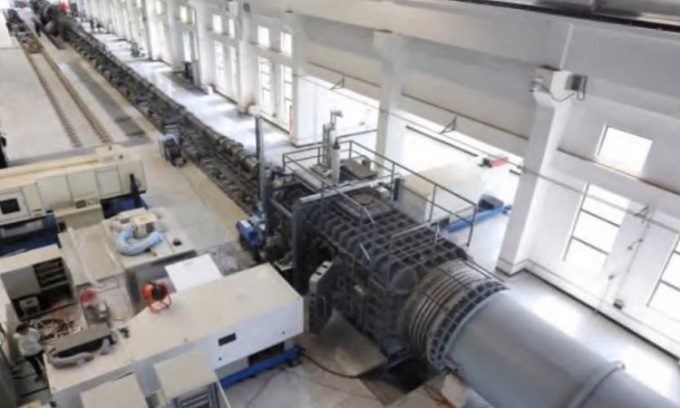Based on the design by Australian scientists, the new wind tunnel can simulate flight conditions at speeds of 2.5 – 11.5 km/s, which is over 33 times the speed of sound.
The world’s largest free piston shock tunnel has commenced operations in southwestern China, enabling high-quality wind tunnel experiments at low costs for supersonic research, according to the expert team involved in the project. The research group hopes that the advanced facility in Sichuan Province will contribute to various missions, such as sending Chinese astronauts to the Moon and developing supersonic aircraft that can reach any location in the world within an hour. With a diameter of 80 cm, this testing tunnel is nearly twice the size of similar facilities in the West.

The Mach 33 wind tunnel located in Mianyang, Sichuan. (Photo: Institute of Supersonic Aerodynamics).
Lyu Zhiguo, the project leader at the Institute of Supersonic Aerodynamics under the Chinese Academy of Aerospace Aerodynamics in Mianyang, and his colleagues described the tunnel in a paper published in the journal Acta Aeronautica et Astronautica Sinica on September 1. According to them, the tunnel can be used for national-level engineering projects such as the return capsule for the Moon landing project, atmospheric entry for interstellar probe missions, and the development of supersonic vehicles, providing ground testing support to simulate conditions at speeds necessary to escape Earth’s gravitational field. However, they did not disclose the construction costs of the facility in Mianyang or whether it was affected by the 6.8 magnitude earthquake that struck Sichuan on September 5.
The free piston shock tunnel, also known as the Stalker tube, is an invention by Australian aerospace engineer Raymond Stalker in the 1960s. The wind tunnel operates using a piston developed by Stalker and his team, allowing Australia to advance high-end supersonic flight technology, such as static jet engines, with limited investment and manpower. Many similar wind tunnels have been constructed worldwide over the past few decades, including the X3 expansion tube at the University of Queensland, which has a diameter of about 40 cm.
The X3 tunnel is connected to a high-pressure nitrogen tank that vibrates along the tube as the piston moves, which can reduce the accuracy of ground test results. Chinese researchers addressed this issue by encasing the nitrogen chamber above the piston launch tube. This design not only reduces the size and complexity of the entire facility but also minimizes vibrations to a fraction compared to standard Stalker tubes.
Another challenge is that the 840 kg piston is heavier than any version previously used in wind tunnels. The piston will accelerate to 540 km/h and must withstand pressures from compressed air that are 10,000 times greater than gravitational force. Lyu’s research team stated that thanks to a unique structural design and the use of new materials, the piston can endure repeated intense testing.
However, all Stalker tubes face a significant issue. The simulations they produce last only about a millisecond, which is too short for certain experiments, such as the chemical reactions of air molecules at high temperatures and tests of energy generators that can capture heat from aircraft surfaces and convert it into electricity. Lyu and his colleagues indicated that the new facility will complement other types of wind tunnels to provide more comprehensive scientific data for China’s supersonic program.




















































